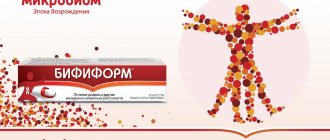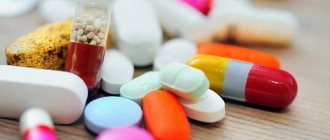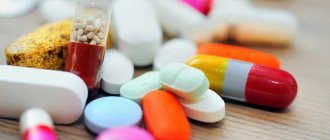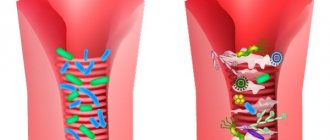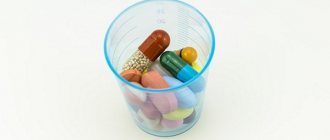Antibiotics are used for infectious diseases caused by bacteria. They either destroy pathogenic microorganisms (bactericidal drugs) or limit their proliferation (bacteriostatic antibiotics), leaving the immune system to fight the infection itself.
In order for antibiotics to be effective, you must follow certain rules for taking them.
Can only be used as prescribed by a doctor
It is very important to take antibacterial agents only in cases where you cannot do without them. It is unacceptable to take medications on your own initiative. Indications for the use of antibiotics include various symptoms of infectious diseases that cannot be treated on your own:
- Prolonged high temperature.
- Purulent processes.
- Exacerbations after pathologies of a bacterial nature.
- Disturbance in the structure of the circulatory system. There is an increase in the level of white cells, an increase in ESR and other characteristic signs indicating inflammation.
It is worth remembering that antibacterial agents are not effective against viruses. Therefore, this pharmacological group is not prescribed to patients to combat influenza, ARVI, and intestinal infections.
Is it possible to overcome resistance?
Over time, the bacteria adapt by producing genes that protect against the effects of antibiotics. If a person becomes infected with such bacteria, it is much more difficult to treat. This process is on a planetary scale, and doctors themselves are largely to blame for the problem. They often thoughtlessly use broad-spectrum antibiotics, which, like carpet bombing, destroy the microflora of the mucous membranes.
“It’s easier to prescribe an antibiotic to a child with a high fever or an unconscious intensive care patient and not worry about further treatment,” complains therapist and medical blogger Philip Kuzmenko. “The doctor simplifies his work by shooting sparrows out of a cannon and achieves the patient’s recovery, but at too high a cost.”
The next time the same disease overtakes a recovered person, the previous medicine may not work, since the bacteria have learned to resist it. In this arms race, microbes have a clear advantage. There will always be bacteria against which even the latest generation of drugs will be powerless.
“Self-medication with antibiotics is the murder of our grandchildren and great-grandchildren,” Dr. Kuzmenko is convinced. — Every day I receive letters that inexperienced or incompetent doctors prescribe antibiotics for ARVI. The mortality rate from influenza does not exceed 2−3%, and from a bacterial infection, for which there is no cure, it reaches 50%. Personally, in the first year of practice I prescribed antibiotics often, then less often, and in the 4th-5th year - almost never. There are 3 groups of so-called antibiotics of choice or first line: penicillins, macrolides and cephalosporins. These drugs are prescribed in case of a threatening situation even before confirmation of an accurate diagnosis. It is a myth that pneumonia can be “heard out” at an early stage, but in some cases the patient may not even make it to the pharmacy. Therefore, empirically, from a variety of antibiotics, “broad-spectrum” drugs were selected that act on 20–25 species of bacteria.”
Accounting for medications used
It is advisable to keep records of all antibiotics used. Namely, it is worth recording the duration of the course, the name of the medicine, when it was taken and for the treatment of what disease. This is recommended not only for children, but also for adults.
During use, you need to take into account the body’s reaction to the drug, the development of possible side effects, and allergies. This will help the doctor adequately assess the situation and prescribe the most effective antibacterial agent.
It is also important to warn the specialist about the use of additional drugs that have been used recently or currently.
Antibiotics must be taken strictly according to the schedule
Your doctor will tell you your dosage regimen. In addition, each drug has instructions that describe in detail when (morning, evening, before/after meals) and how many times a day the medicine should be taken. Antibiotics should be taken at the same time, and the intervals between doses should be equal. Usually the drug is taken 1-2-3-4 times a day, which means the intervals should be 24-12-8-6 hours. This is the period of time the pill works, then its effect ends, and if you miss the time of taking it, the bacteria will begin to multiply intensively, poisoning the body. In addition, microorganisms may develop resistance to this antibiotic.
Taking probiotics
Everyone knows that antibacterial drugs have a detrimental effect on the intestinal microflora, especially with long-term use. Therefore, during the course of treatment you should additionally take probiotics and consume various dairy dishes. It is advisable to take such medications between intervals of taking the main drug.
Effective representatives of probiotics: Linex, Bifiform, Acipol, Normoflorin. It is advisable to consult a doctor about choosing the appropriate remedy.
Don't repeat at home
An antibiotic is a powerful medicine and should always be prescribed by a doctor. For more than two decades, many pharmacies, in an effort to increase revenue, freely sold prescription drugs, except for narcotic and psychotropic drugs. This led to the fact that many doctors forgot how to fill out prescription forms, writing prescriptions on pieces of paper without even stamping them. And patients bought antibacterial, also known as antimicrobial, drugs for self-medication. Control has only tightened in the last two years.
“Even before I started working at the Fantasy Children’s Clinic,” says pediatrician Victoria Alipova, “a child was brought to the appointment who complained of abdominal pain and bowel movements. The medical history showed that the boy had been treated with antibiotics 12 times over the past year for every cold, including ARVI, when such medications are useless. For the first time, the doctor prescribed an antibiotic, and then the child’s mother acted by analogy. It was enough to stop the drug, and the problem with the intestines would normalize. Children can take antimicrobials in the form of syrups or suspensions even from birth, but only according to indications determined by the doctor. Many doctors prescribe such medications for any reason.”
Antibiotics have many side effects. First of all, they destroy the intestinal microflora: diarrhea, vomiting, possible colitis, liver and kidney dysfunction, and allergies. In such cases, probiotics or other drugs that normalize the functions of the gastrointestinal tract are often prescribed in parallel. However, urologist Rinaz Kamaletdinov says that the clinical recommendations do not indicate that such drugs can stabilize the intestinal microflora against the background of antibacterial therapy. And in each case of illness, only a specialist can make a decision on the type of therapy:
“Treatment with antibiotics should be carried out by a doctor,” Dr. Kamaletdinov is sure. - Even if similar symptoms reappear, you should not take the pills left over from your previous illness. You can consult a doctor online or by phone. In urology, different types of antibiotics are used, most often fluoroquinolones, especially levofloxacin. It is often necessary to change the pharmacological group, dose, duration and schedule of administration. For example, a patient with bacterial prostatitis caused by Escherichia coli was given one type of antibiotic. Treatment requires 28 days, but symptoms returned in the 3rd week. It turned out that a second infection appeared in the body, and E. coli developed resistance to the drug. I had to additionally prescribe a drug of a different spectrum.”
Probiotics are the best protection for microflora
Normoflorins L, B, D
How can we normalize the intestinal microflora that has become a victim of traditional antibiotic therapy? This question is more than relevant today for a large number of people, but there is only one answer - only probiotics . This is the name for special products that can not only support and restore normal intestinal microflora, but also populate the intestines with such microflora. The uniqueness and advantage of probiotics is that they contain live strains of beneficial bacteria. When they colonize the intestines, the opportunistic flora is forced to give up their positions. As a result, the digestive system is restored to its healthy state prior to the course of antibiotics.
In addition to restoring normal intestinal function and improving digestion, probiotics participate in strengthening local and general immunity, and synthesize much-needed vitamins such as groups B and K. All these vital processes occur thanks to the active work of lacto- and bifidobacteria, which are part of probiotic complexes. To forestall your possible doubts, we note: the use of probiotics as a restorative agent after antibiotic therapy is absolutely safe. As for the effectiveness, it can be judged by the example of biocomplexes known as Normoflorins . These are special natural preparations, produced in liquid form, which are a mixture of lactobacilli and bifidobacteria with their metabolic products - vitamins and minerals, antimicrobial nutrients and organic acids. In addition, Normoflorins contain a very valuable ingredient - the disaccharide lactitol, which serves as excellent nutrition for a person’s own microflora, thereby stimulating its growth and development.
The first Russian scientist to seriously study the effect of probiotics on the restoration of microflora was I.I. Mechnikov. He based his work on observations of lactic acid bacillus, arriving at excellent results. However, probiotics are not necessarily just bacteria. These may include other protozoa. Let's say yeast.
When are probiotics most effective?
The list of diseases and pathological conditions for which the use of probiotic complexes is recommended is quite extensive. For antibiotic-associated diarrhea, American gastroenterologists, for example, recommend a combination of strains of Lactobacillus plantarum and Bifidobacterium infantis in a “community” with the fungi Sacchromyces boulardii. For infectious diarrhea caused by ARVI pathogens, two types of lactobacilli are indicated - Lactobacillus casei and Lactobacillus rhamnosus.
Of considerable importance to achieve the desired effect is the survival rate of microorganisms that we obtain from probiotic complexes. In other words, how high is their biochemical activity in the gastrointestinal tract. In addition to the above-mentioned lacto- and bifidobacteria, propionic acid bacteria Propionic bacterium are among the most “tenacious”. They not only restore the gastrointestinal tract after the “invasion” of antibiotics, but also act as immunomodulators. In addition, they suppress the development of many mutations, reduce the toxic effects of a number of chemicals and promote the growth and development of fecal bifidobacteria.
Back to list Previous article Next article
Types of antibiotics
All types of drugs have a strong effect and include a wide range of effects on pathogenic microorganisms.
Amoxiclav
A complex drug that includes amoxicillin actively fights viral infection. The second component, clavulanic acid, inhibits bacterial synthesis. The antibiotic is indicated for symptoms such as:
- bronchitis;
- pneumonia;
- lung abscess.
If the virus has entered the bloodstream, the medication will quickly help cope with sepsis.
Side effects may include:
- jaundice, hepatitis, impaired stool formation;
- allergic reactions;
- kidney inflammation;
- candidiasis.
Fluimucil
The drug contains triamphenicol. Used as inhalation and injection. The antibiotic has expectorant, mucolytic and bactericidal properties. When the patient has a moderate condition, he is prescribed inhalations with the drug. The substance is absorbed into the bloodstream in small quantities, so the risk of side effects is minimal. However, they still exist and can be expressed in the form of an allergic rash, stomatitis, and pancytopenia.
Azithromycin
An antibiotic is one of the most potent drugs. Produced in ampoules and tablets, it can be used both intravenously and intramuscularly. Actively affects bacterial cells by suppressing protein synthesis, reproduction, and enzymes. Effectively fights otitis, sinusitis, tonsillitis, bronchitis.
The drug is indicated for identifying infectious pathologies caused by inflammation of the respiratory tract, and therefore can be used to treat coronavirus. There are a lot of side effects, however, they can be avoided if you follow the recommendations for use.
Ceftriaxone
The drug has a strong effect on pathogenic microorganisms. When it enters the body, a bactericidal effect occurs, all bacteria are destroyed, which eliminates the risk of chronic diseases. The drug is usually prescribed during the complicated viral phase. Side effects may include:
- candidiasis;
- allergic rash;
- dyspepsia;
- kidney inflammation.
What to drink with antibiotics for microflora?
Normalization of beneficial microflora is carried out by lacto- and bifidobacteria contained in probiotics and prebiotics. These biological products are not taken simultaneously with antibacterial agents, since the active substance of the drug will destroy beneficial bacteria along with the pathogenic flora. They are consumed no earlier than 2 hours later, or the flora is restored after completing a course of antibiotic therapy. It is advisable to take biological products for at least 14 days, ideally up to 30 days. In most cases, the patient’s immunity itself restores the balance of microflora.
